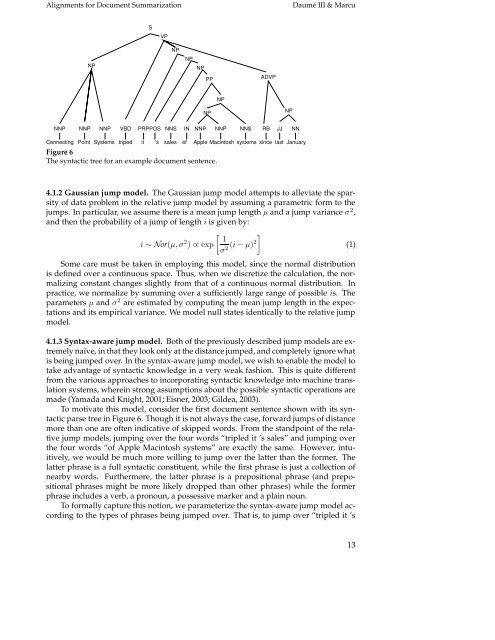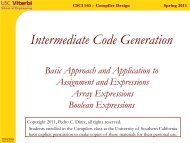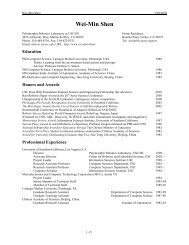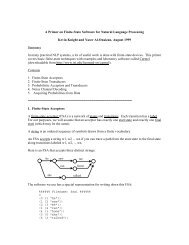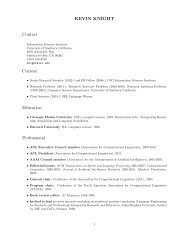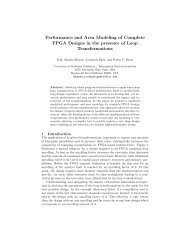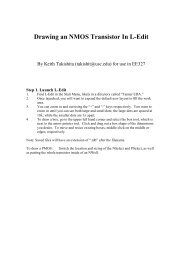Induction of Word and Phrase Alignments for Automatic Document ...
Induction of Word and Phrase Alignments for Automatic Document ...
Induction of Word and Phrase Alignments for Automatic Document ...
Create successful ePaper yourself
Turn your PDF publications into a flip-book with our unique Google optimized e-Paper software.
<strong>Alignments</strong> <strong>for</strong> <strong>Document</strong> Summarization Daumé III & Marcu<br />
NP<br />
S<br />
VP<br />
NP<br />
NNP NNP NNP VBD PRPPOS NNS IN NNP NNP NNS RB JJ NN<br />
Connecting Point Systems triped it ’s sales <strong>of</strong> Apple Macintosh systems since last January<br />
Figure 6<br />
The syntactic tree <strong>for</strong> an example document sentence.<br />
NP<br />
NP<br />
4.1.2 Gaussian jump model. The Gaussian jump model attempts to alleviate the sparsity<br />
<strong>of</strong> data problem in the relative jump model by assuming a parametric <strong>for</strong>m to the<br />
jumps. In particular, we assume there is a mean jump length µ <strong>and</strong> a jump variance σ2 ,<br />
<strong>and</strong> then the probability <strong>of</strong> a jump <strong>of</strong> length i is given by:<br />
i ∼ Nor(µ, σ 2 � �<br />
1<br />
) ∝ exp (i − µ)2<br />
(1)<br />
σ2 Some care must be taken in employing this model, since the normal distribution<br />
is defined over a continuous space. Thus, when we discretize the calculation, the normalizing<br />
constant changes slightly from that <strong>of</strong> a continuous normal distribution. In<br />
practice, we normalize by summing over a sufficiently large range <strong>of</strong> possible is. The<br />
parameters µ <strong>and</strong> σ 2 are estimated by computing the mean jump length in the expectations<br />
<strong>and</strong> its empirical variance. We model null states identically to the relative jump<br />
model.<br />
4.1.3 Syntax-aware jump model. Both <strong>of</strong> the previously described jump models are extremely<br />
naïve, in that they look only at the distance jumped, <strong>and</strong> completely ignore what<br />
is being jumped over. In the syntax-aware jump model, we wish to enable the model to<br />
take advantage <strong>of</strong> syntactic knowledge in a very weak fashion. This is quite different<br />
from the various approaches to incorporating syntactic knowledge into machine translation<br />
systems, wherein strong assumptions about the possible syntactic operations are<br />
made (Yamada <strong>and</strong> Knight, 2001; Eisner, 2003; Gildea, 2003).<br />
To motivate this model, consider the first document sentence shown with its syntactic<br />
parse tree in Figure 6. Though it is not always the case, <strong>for</strong>ward jumps <strong>of</strong> distance<br />
more than one are <strong>of</strong>ten indicative <strong>of</strong> skipped words. From the st<strong>and</strong>point <strong>of</strong> the relative<br />
jump models, jumping over the four words “tripled it ’s sales” <strong>and</strong> jumping over<br />
the four words “<strong>of</strong> Apple Macintosh systems” are exactly the same. However, intuitively,<br />
we would be much more willing to jump over the latter than the <strong>for</strong>mer. The<br />
latter phrase is a full syntactic constituent, while the first phrase is just a collection <strong>of</strong><br />
nearby words. Furthermore, the latter phrase is a prepositional phrase (<strong>and</strong> prepositional<br />
phrases might be more likely dropped than other phrases) while the <strong>for</strong>mer<br />
phrase includes a verb, a pronoun, a possessive marker <strong>and</strong> a plain noun.<br />
To <strong>for</strong>mally capture this notion, we parameterize the syntax-aware jump model according<br />
to the types <strong>of</strong> phrases being jumped over. That is, to jump over “tripled it ’s<br />
PP<br />
NP<br />
NP<br />
ADVP<br />
NP<br />
13


